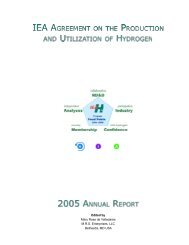Technology Status of Hydrogen Road Vehicles
Technology Status of Hydrogen Road Vehicles
Technology Status of Hydrogen Road Vehicles
You also want an ePaper? Increase the reach of your titles
YUMPU automatically turns print PDFs into web optimized ePapers that Google loves.
Moore, R.B.; V. Raman, “<strong>Hydrogen</strong> infrastructure for fuel cell transportation,” Air Products and<br />
Chemicals, Pennsylvania, USA, pp. 133-142.<br />
More than 8.5 million tonnes <strong>of</strong> H 2 are produced in the United States each year, but more than 95% is used<br />
in-situ to refine oil or produce commodity chemicals such as ammonia and methanol.<br />
The remaining “merchant” H 2 is used in the chemicals, metals, glass, and electronics industries. Only a tiny<br />
fraction is used for transport, above all for the space program, and the LH 2 production capacity is 80 tonnes/yr<br />
distributed in 20,000 trailer loads /yr.<br />
The paper examines the infrastructure options to supply fueling stations, each with 500 cars/d capability (2.7<br />
tonnes/d H 2); a home option for one car is also examined. Three main options, and some subdivisions, are<br />
costed.<br />
The options and costs under today’s market conditions, are:<br />
1. Large-scale LH 2 production at remote natural gas wells, by steam methane reforming (SMR), shipped by<br />
tankers an average <strong>of</strong> 800 km to 10-100 fueling stations. The remote plant maintains 5 days storage, the<br />
fueling station 1.5 days’ storage, and the LH 2 is vaporized at 340 atm for vehicle use. The H 2 price at the<br />
station would be $3.35/kg for a 27 tonne/d remote plant, and $2.35/kg for a 270 tonne/d plant.<br />
2. Large regional and local GH 2 production by SMR <strong>of</strong> natural gas at 15-30 atm.; 50-km pipelines in straight<br />
radial directions, each with 10 fueling stations spaced 5 km apart. Only 1.5 days’ storage at plant, none<br />
at fueling stations. The H 2 price at the station would be $2.91/kg for 27 tonnes/d plant feeding one<br />
pipeline, and $2.47/kg for 270 tonnes/d plant feeding 10 pipelines.<br />
3. Individual fueling station producing 2.7 tonnes/d H 2 by SMR <strong>of</strong> natural gas. One-half day storage at<br />
station. The H 2 price would be $3.57/kg.<br />
4. Same as #3, but using on-site partial oxidation <strong>of</strong> heavy oil as production method. The H 2 price would<br />
be $3.96/kg.<br />
5. Home garage electrolysis producing 3 kg/d GH 2 for one car, half tank per day. The H 2 price would be<br />
$6.97/kg.<br />
6. Same as #3 and #4, except methanol stored and reformed at fueling station. The H 2 price would be<br />
$3.76/kg.<br />
The paper concludes with a discussion on how the market could grow, depending on the preferred form <strong>of</strong> onboard<br />
hydrogen storage.<br />
Specht, M., et al., “Comparison <strong>of</strong> the renewable transportation fuels liquid hydrogen and methanol<br />
with gasoline--energetic and economic aspects,” Center for Solar Energy and <strong>Hydrogen</strong> Research,<br />
University <strong>of</strong> Stuttgart, Germany, pp. 227-239.<br />
These researchers have developed a process to extract CO 2 from the atmosphere and combine it with H 2 from<br />
sources such as hydroelectricity to produce methanol. This process, which includes shipping the product to<br />
Europe, is now compared to LH 2 from the same hydropower, and both are compared to crude oil-gasoline<br />
production from energy efficiency and cost viewpoints.<br />
The overall efficiency <strong>of</strong> the crude oil-gasoline-vehicle system is about 19%, compared to about 9% for LH 2<br />
and slightly more for pure methanol. The costs are determined largely by the energy input and capital cost<br />
<strong>of</strong> production plants. When used in ICE cars, the renewable-based methanol and LH 2 are approximately equal;<br />
gasoline is about 25% cheaper, all based on untaxed fuel.<br />
Apart from a possible tax advantage for environmentally benign fuels such as LH 2 and methanol, the advent<br />
56













